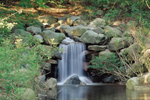Prospect Park
Prospect Park is a 585-acre public park in the New York City borough of Brooklyn located between Park Slope, Prospect-Lefferts Gardens, Kensington, Windsor Terrace and Flatbush Avenue, Grand Army Plaza and the Brooklyn Botanic Garden. It is run and operated by the New York City Department of Parks and Recreation and is part of the Brooklyn-Queens Greenway.
The park was designed by Frederick Law Olmsted and Calvert Vaux after they completed Manhattan’s Central Park. Attractions include the Long Meadow, a 90-acre meadow thought to be the largest meadow in any U.S. park;[citation needed] the Picnic House, which houses offices and a hall that can accommodate parties with up to 175 guests; Litchfield Villa, the home of Edwin Clark Litchfield, an early developer of the neighborhood and a former owner of a southern section of the Park; Prospect Park Zoo; a large nature conservancy managed by the Wildlife Conservation Society; The Boathouse, housing a visitors center and the first urban Audubon Center; Brooklyn’s only lake, covering 60 acres; the Prospect Park Bandshell that hosts free outdoor concerts in the summertime; and various sports and fitness activities including seven baseball fields. There is also a private Society of Friends cemetery on Quaker Hill near the ball fields, where actor Montgomery Clift is interred.
Approximately 17,000 years ago the terminal moraine of the receding Wisconsin Glacier that formed Long Island established a string of hills and kettles in the northern part of the park and a lower lying out wash plain in the southern part. Mount Prospect, or Prospect Hill, near the intersection of Flatbush Avenue and Eastern Parkway, rises 200 feet above sea level and is the highest among a string of hills that extends into the park, including Sullivan, Breeze, and Lookout hills. The area was originally forested, but became open pasture after two centuries of European colonization. Significant stands of trees remained only in the peat bogs centered south of Ninth Street and Flatbush Avenues, and in a large bog north of Ninth Avenue and contained chestnut, white poplar, and oak. Some of these stands were preserved in the Park’s Ravine and have been popularized as ‘The Last Forest of Brooklyn.’
During the American Revolution the Park was a site of the Battle of Long Island. American forces attempted to hold Battle Pass, an opening in the terminal moraine where the old Flatbush Road passed from Brooklyn to Flatbush. It fell after some of the heaviest fighting in the engagement, and its loss contributed to George Washington’s decision to retreat. The City of Brooklyn built a reservoir on Prospect Hill in 1856. Preserving the Battle Pass area and keeping the lots around the reservoir free of buildings were two reasons for establishing a large park in the area.
